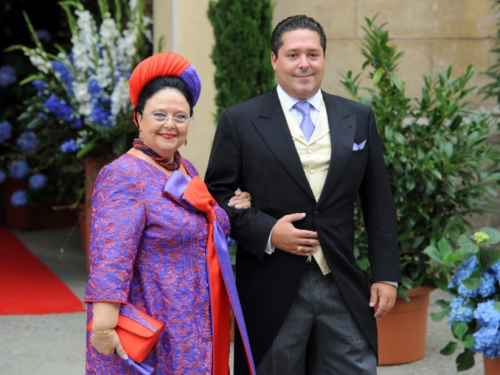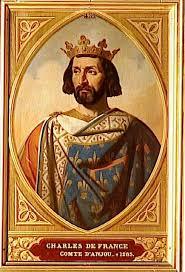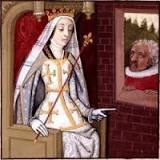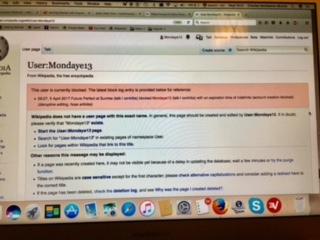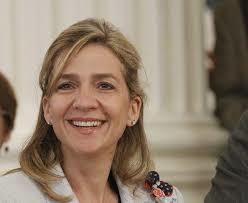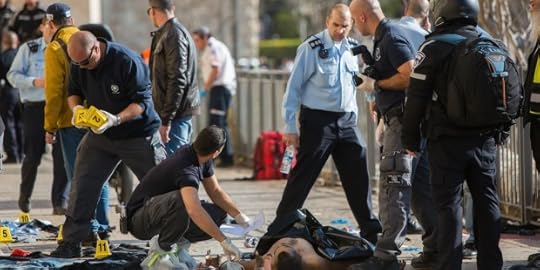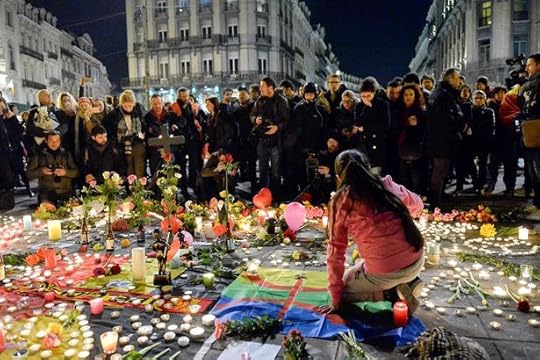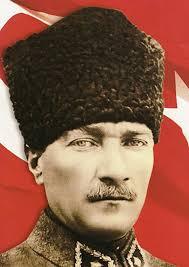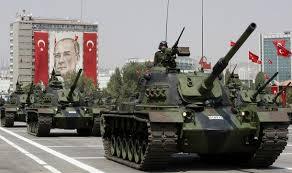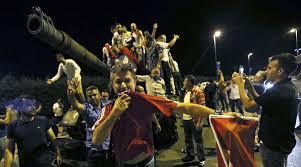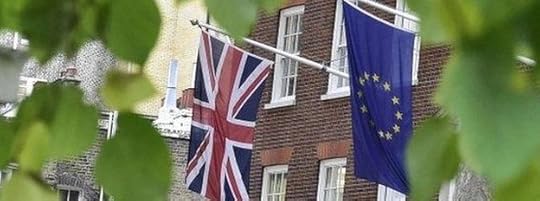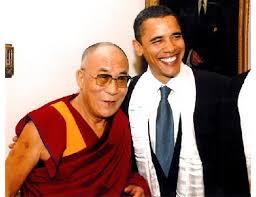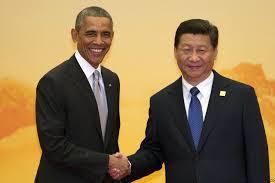Carlos Mundy's Blog
July 18, 2017
Grand Duchess Maria Vladimirovna and her justified claim to the Imperial throne of Russia
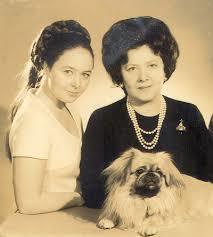 H.I.H Grand Duchess Maria Vladimirovna with her mother Grand Duchess Vladimir in Madrid.
H.I.H Grand Duchess Maria Vladimirovna with her mother Grand Duchess Vladimir in Madrid.
Grand Duchess Maria Vladimirovna attended the same school that I did in Madrid: Runnymede College where we prepared ourselves for our “O” and “A” Levels of Cambridge University. I have had the honour of knowing Her Imperial Highness since those days. I was invited to the baptism of her son and heir, Grand Duke George at their family home in Puerta de Hierro in Madrid. Their Majesties King Juan Carlos and Queen Sophia of Spain attended the celebration as the relationship between the Spanish Royal House and the Vladimirovichs has always been excellent. I only have praise for her and her work on behalf of the monarchy in Russia.
On the death of her father, Grand Duke Vladimir Kyrilovich in Miami on the 21 April 1992, she became the Head of the Imperial House of Russia though the Romanov Family Association do not recognize her as such, for reasons that in my opinion are mistaken and that will be discussed further on in my article. It is important to note as gestures are sometimes more important than words that His body was returned to Russia and he was buried with full pomp and splendour in the Peter and Paul Fortress in St. Petersburg , the first Romanov to be honoured in this way since before the revolution.
To be able to enter into what seems the complicated laws of succession to the Imperial throne we must turn to the Pauline Laws. The Pauline Laws are the house laws of the House of Romanov and the name comes from the fact that they were initially established by Emperor Paul I in 1797.
Tsar Paul I abolished Peter the Great’s law which allowed each reigning emperor or empress to designate his or her successor, substituting a strict order of succession by proclaiming that the eldest son of the monarch shall inherit the throne, and other dynasts according to primogeniture in the male-line. In so doing, Tsar Paul implemented a semi-Salic line of succession to the Russian throne: The throne could henceforth pass to a female and through the female (cognatic) line of the dynasty, upon the extinction of all legitimately-born, male dynasts.
The Pauline laws established a very strict marriage policy by which only marriages approved by the Tsar and to members of a Royal or Ruling family, were considered dynastic and acceptable. I suggest you read further details on this matter by clicking on the following link:
http://https://www.wikiwand.com/en/Pauline_Laws
After the forced abdication of Nicholas II on the 15th March 1917 of the throne in his name and that of his son, his brother Grand Duke Michael was proclaimed “Emperor Michael II,” to Russian troops and in cities throughout Russia but the new Emperor deferred to the will of the people and acknowledged the Provisional Government as the de facto executive, but neither abdicated nor refused to accept the throne. In his statement he said:
“Inspired, in common with the whole people, by the belief that the welfare of our country must be set above everything else, I have taken the firm decision to assume the supreme power only if and when our great people, having elected by universal suffrage a Constituent Assembly to determine the form of government and lay down the fundamental law of the new Russian State, invest me with such power.
Calling upon them the blessing of God, I therefore request all the citizens of the Russian Empire to submit to the Provisional Government, established and invested with full authority by the Duma, until such time as the Constituent Assembly, elected within the shortest possible time by universal, direct, equal and secret suffrage, shall manifest the will of the people by deciding upon the new form of government.”
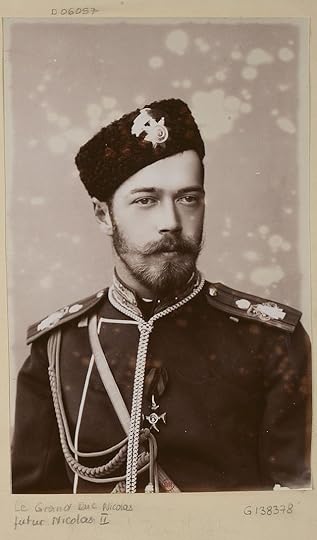 His Majesty Tsar Nicholas II when he was Tsarevich
His Majesty Tsar Nicholas II when he was Tsarevich
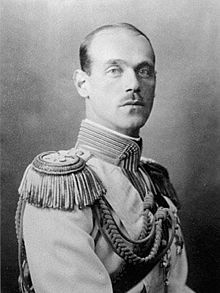 Grand Duke Michael Alexandrovich, brother of Tsar Nicholas II and proclaimed Tsar Michael II
Grand Duke Michael Alexandrovich, brother of Tsar Nicholas II and proclaimed Tsar Michael II
After the fall of the monarchy and the disappearance of Tsar Nicholas II and his family in Ekateringburg (I am yet to be convinced without a doubt of the generally accepted official version of the assassination and its important to not forget that the Russian Orthodox Church to this day has not recognized the authenticity of the remains and declined to attend the reburial ceremony in 1998 ), Grand Duke Nikolaievich was proclaimed as the emperor of all Russia by the Zemsky Sobor of the Priamursk Region by the Provisional Priamurye Government which controlled portions of the Russian Far East, convened in Vladivostok by General Mikhail Diterikhs who appreciated his career as general and former commander-in-chief, and his position as the oldest member of the imperial dynasty. At the time, Grand Duke Nicholas was already living abroad and consequently was not present at the Sobor. Two months later the Priamursk region fell to the Bolsheviks thus his rule was nominal as he was living in exile during the entirety of his reign that ended when he died in 1929 without issue. In any case Dowager Empress Maria Feodorevna who was living in exile Denmark did not take seriously this proclamation as she believed until her death on the 13th October 1928 that Her son and grandchildren had not been murdered.
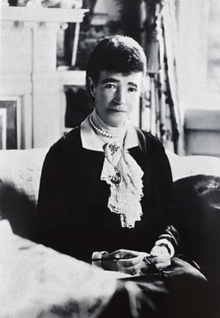 Her Imperial Majesty Dowager Empress Maria Feodorovna in Denmark after the fall of the monarchy.
Her Imperial Majesty Dowager Empress Maria Feodorovna in Denmark after the fall of the monarchy.
Despite, the Dowager Empress’ believes, camps started to be formed in the monarchist movement, where Paris was a focal location. Several monarchists grouped around Grand Duke Cyril Vladimirovich, who was first in the line of succession by male primogeniture after the alleged murder of Tsar Nicholas II, Tsareich Alexei and Grand Duke Michael Alexandrovich. Many of Cyril’s opponents grouped around a young Grand Duke Dimitri Paulovich, who was next in the line of succession if Cyril and his brothers, the Vladimirovichi, were ineligible (Paul Alexandrovich, who had been ahead of Dmitri, had been killed in 1919), but Dimitri himself refused these advances, supporting instead Grand Duke Cyril as emperor. In any case neither for this reason neither Grand Duke Nikolai Nikolaievich or Grand Duke Dimitri Paulovich proclaimed there rights to the throne out of respect to the feelings of the Dowager Empress but Cyril
 Grand Duke Kyril Vladimirovich who proclaimed himself Tsar Kyril I on the 31st August 1924.
Grand Duke Kyril Vladimirovich who proclaimed himself Tsar Kyril I on the 31st August 1924.
Vladimirovich assumed on 8 August 1922 the position of curator of the throne and on 31 August 1924 he proclaimed himself Kyril I, Emperor of all the Russias. With the assumption of the Imperial title his children were elevated to the title and styles of Grand Duke and Grand Duchesses of Russia according to the Statutes of the Imperial Family and the Laws of the Russian Empire. Grand Duke Kyril’s role as head of the House was recognized, and the oath of loyalty signed by every male dynast of the House of Romanov, except Grand Duke Nicholas, his brother Grand Duke Peter, and the latter’s son, Prince Roman Petrovich. Tsar Kyril held his court-in-exile in France, erecting a secretariat for the monarchist movement until his death in 1938 when his only son, Grand Duke Vladimir Kirillovich, succeeded him though he chose to assume the title of “Grand Duke” rather than that of Emperor. Sadly for the family this succession would be surrounded by controversy and to understand the reason for the controversy instigated by the Romanov Family Association we must go back to the Pauline Laws.
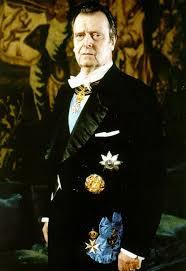 His Imperial Highness Vladimir Kyrilovich Romanov, Grand Duke of Russia
His Imperial Highness Vladimir Kyrilovich Romanov, Grand Duke of Russia
As mentioned previously the Pauline Laws were very strict in regard to dynastic marriages and the laws provide for succession by both male and female dynasts and establishing male-preference primogeniture. This means that succession to the throne (or headship of the dynasty) passes by primogeniture to the senior male dynast. At the death of the last male dynast, the succession passes to the female dynast most closely related to the last emperor.
Grand Duke Vladimir married Princess Leonida Georgievna Bagration-Moukhransky on the 13th August 1948 in Lausanne. The Pauline Laws dictated that only those born of a dynastic marriage between a Romanov dynast and a member of a “royal or sovereign house”, were included in the Imperial line of succession; children of morganatic or unequal marriages were ineligible to inherit the throne or dynastic status. For the supporters of Grand Duke Vladimir he was the sole male dynast of the Imperial House to enter into an equal marriage after the 1917 revolution but his opponents refuted the equality of this marriage and they do so to this day.
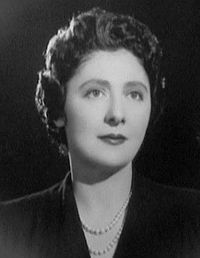 Her Imperial Highness Grand Duchess Leonida at the time of her marriage.
Her Imperial Highness Grand Duchess Leonida at the time of her marriage.
The family to which Princess Leonida belonged, the Bagrationi dynasty, had been kings in Georgia from the medieval era until the early 19th century, but no male line ancestor of hers had reigned as a king in Georgia since 1505 and her branch of the Bagrations, the House of Mukhrani, had been naturalised among the non-ruling nobility of Russia after Georgia was annexed to the Empire in 1801. Yet the royal status of the House of Bagration had been recognized by Russia in the 1783 Treaty of Georgievsk and was confirmed by Vladimir Kirillovich on 5 December 1946 as head of the Russian imperial house. Therefore this controversy fueled by some members of the family, has no legal standing specially in view that the Republic of Georgia later recognized the Bagrations as their royal family and invited the head of the family back to Georgia. This means that it is a fact that Grand Duke Vladimir Kyrilovich was the sole male dynast of the Imperial House to enter into an equal marriage after the revolution.
In any case in 1946 in his capacity of Head of the Russian Imperial Family, Grand Duke Vladimir recognised the Moukhransky branch of the House of Bagration as a former Royal dynasty and he declared his 1948 marriage to Princess Leonida to be dynastic, notwithstanding her family’s status as Russian subjects at the end of the monarchy. From the time of their marriage in 1948 she assumed her husband’s rank, bearing the title Grand Duchess of Russia and the style Her Imperial Highness.
For further information on this please click on the following link:
In 1969 Grand Duke Vladimir, expressing his opinion that the House of Romanov faced almost inevitable extinction in the dynastic male line, proclaimed his daughter Grand Duchess Maria Vladimirovna the future curatrix of the throne, implying that she would ultimately succeed.
In 1989, when Prince Vasili Alexandrovich of Russia (who was also the President of the Romanov Family Association, died, Grand Duke Vladimir proclaimed his daughter as the dynasty’s heiress, as Prince Vasili was the last male Romanov other than himself whom, having been born of an equal marriage, was recognized as a dynast.
For nearly two centuries, from the accession of Emperor Paul I in 1796 to the death of Grand Duke Wladimir in 1992, male dynasts held the throne or headship of the dynasty, based on primogeniture. Due to the numerous non-dynastic marriages that occurred after the Revolution of 1917, the male dynasts of the Imperial House grew smaller in number as the years passed and finally died out in 1992 when Grand Duke Vladimir Kirillovich died in 1992. With no existing male dynasts, Maria Vladimirovna assumed the position of Head of the House as “de jure” Empress and proclaimed her son George Mikhailovich as heir-apparent. Since that day she has worked tirelessly to promote the sentiment of monarchy in Russia with great success.
Her Imperial Highness Maria Vladimirevna Romanov, Grand Duchess of Russia
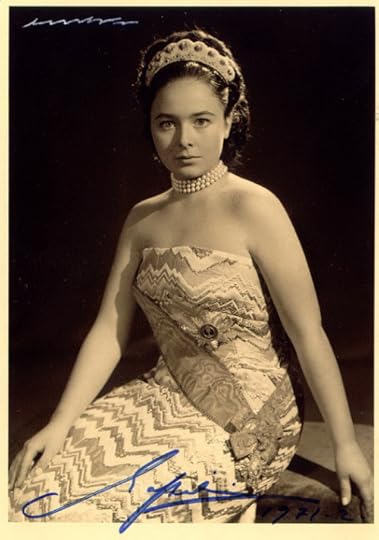 Her Imperial Highness Grand Duchess Maria Vladirmirevna on her dynastic coming of age on her 16th birthday.
Her Imperial Highness Grand Duchess Maria Vladirmirevna on her dynastic coming of age on her 16th birthday.
The Grand Duchess was born in Madrid, where her parents resided since the end of the II World War. Her godfather was H.R.H Prince Nicholas of Romania and her godmother,Queen Ioanna of Bulgaria. She was educated in Madrid and Paris, before studying Russian history and literature at Oxford University and is fluent in Russian, English, French and Spanish, and also speaks some German, Italian and Arabic.
On 23 December 1969, upon reaching her dynastic majority, Grand Duchess Maria swore an oath of loyalty to her father, to Russia, and to uphold the Fundamental Laws of Russia which governed succession to the Imperial throne. At the same time, her father issued a controversial decree recognizing her as heiress and declaring that, in the event he predeceased other dynastic Romanov males, then the Grand Duchess would become the “Curatrix” “of the Imperial Throne until the death of the last male dynast. The heads of the other branches of the imperial family, declared that Grand Duke Vladimir’s actions were not legal but as it happened he outlived all the other male Romanov dynasts, and thus Grand Duchess Maria had no occasion to assume curatorship but directly became “de jure” Empress of Russia.
According to the Russian Legitimist Organization as there are no male dynasts, the succession to the headship of the dynasty has passed legally passed to Grand Duchess Maria Wladimirovna because she is the surviving female dynast most closely related to the last emperor, Tsar Nicholas II (or Michael II) but The Romanov Family Association is not in agreement with this point of view or this interpretation of the Pauline Laws.
On 22 September 1976, the Grand Duchess married His Royal and Imperial Highness Prince Franz Wilhelm of Prussia, her third cousin, once-removed. He is a great-grandson of Germany’s last emperor, Kaiser Wilhelm II and a great-great-great grandchild of Queen Victoria of the United Kingdom. Franz Wilhelm converted to the Orthodox faith prior to the wedding, taking the name Michael Pavlovich and receiving the title of a Grand Duke of Russia from Grand Duke Vladimir.
The couple separated in 1982, a year after the birth of their only child, George Mikhailovich, who had been granted the title Grand Duke of Russia at birth by his grandfather.
 Grand Duchess Vladimir with her husband Grand Duke Vladimir and Grand Duke George Mikhailovich and his mother Grand Duchess Maria Vladimirevna.
Grand Duchess Vladimir with her husband Grand Duke Vladimir and Grand Duke George Mikhailovich and his mother Grand Duchess Maria Vladimirevna.
The “de jure” Empress hopes for the restoration of the monarchy someday and is “ready to respond to a call from the people”. When questioned about the ongoing rift among Romanov descendants, the Empress said:
“Attempts to disparage my rights have originated with people who, firstly, do not belong to the Imperial Family, and, secondly, either do not themselves know the relevant laws or think that others do not know these laws. In either case, there is unscrupulousness at work. The only thing that causes ne regret is that some of our relatives waste their time and energy on little intrigues instead of striving to be of some use to their country. I have never quarreled woth anyone about these matters and I remain open to discussions and cooperation with all, including, of course, my relatives.But there can be no foundation for cooperation without respect four our dynastic laws, fulfilling these laws, and following our family traditions”
Despite the dispute between Grand Duchess Maria and the Romanov Family Association the reality is that she is acknowledged as Head of the Russian Imperial House by all the European Royal Houses.
 Grand Duchess Maria Vladimirevna with Her Majesty Queen Elisabeth II at the Ivy in London
Grand Duchess Maria Vladimirevna with Her Majesty Queen Elisabeth II at the Ivy in London
 The “de jure” Empress of Russia, with her son Tsarevich George and His Majesty Tsar Simeon of Bulgaria and His Majesty King Michael of Romania.
The “de jure” Empress of Russia, with her son Tsarevich George and His Majesty Tsar Simeon of Bulgaria and His Majesty King Michael of Romania.
The Romanov Family Association
In 1979, seven undisputed male and female dynasts founded the Romanov Family Association (RFA), which by the end of the same year had admitted more than half of the surviving undisputed dynasts into its membership, as well as a fair number of those male-line descendants that Grand Duke Vladimir did not recognize as dynasts because of morganatic birth. Grand Duke Vladimir Kyrillovich never joined the association and neither has Grand Duchess Maria.
The RFA, which included the last two surviving females recognised as dynasts among its membership, chose Prince Nicholas Romanov, as its president in 1989, following the death of Prince Vasili Alexandrovich of Russia, the only undisputed male dynast still living at that time other than Grand Duke Vladimir Kirillovich. The RFA’s official position, expressed in its founding charter, is that the Russian nation should determine which sort of government its people desire and, if the choice is monarchy, who should be monarch. Nonetheless, once Grand Duke Vladimir was no longer alive, they recognized Prince Nicholas Romanov as the head of the Imperial House of Romanov while serving as third president of the RFA. Nicholas took ” His Highness Prince of Russia” as his his title following the death of Grand Duke Vladimir Kyrillovich.
After Nicholas’ death in 2014, his brother Prince Dimitri Romanov took up the claim. In July 2009 Dimitri had affirmed that his brother Nicholas, and not Grand Duchess Maria Vladimirovna, was the Head of the Imperial Family, simultaneously declaring, however, that pursuant to a 1992 family meeting he attended in Paris, all of the then living senior male descendants of the House of Romanov agreed not to put forward any claim. Prince Dimitri died childless in 2016, extinguishing the asserted claims of the Romanovs of the Nikolayevich branch with the death of the last male of that line. A sad and unnecessary family dispute!
Conclusions
In my opinion the only member of the Romanovs that has been educated and prepared for her position has been Grand Duchess Maria Vladimirevna. Since she became Head of the Imperial House she has worked tirelessly to promote the restoration of the monarchy in Russia. Thanks to her efforts and with the help of her son and heir presumptive, Grand Duke George Mikhailovich she has been accepted by most of the royalist parties as Head of the Imperial House and is recognized as such by the Russian government and in March 2013, her claim was recognized by the head of the Russian Orthodox Church, Kyrill I, Patriarch of Moscow and all Russia and this has drawn further supporters among Russians to her cause and the possibility of the restoration of the monarchy. In an interview, the patriarch firmly rejected the claims of the other Romanov descendants and stated, “Today, none of those persons who are descendants of the Romanovs are pretenders to the Russian throne. But in the person of Grand Duchess Maria Vladimirevna and her son, George, the succession of the Romanovs is preserved — no longer to the Russian Imperial throne, but to history itself.”
 The “de jure” Empress of Russia
The “de jure” Empress of Russia
Links:
http://www.russianlegitimist.org/
http://www.imperialhouse.ru/en/
April 24, 2017
The truth about the Royal House of Anjou-Naples
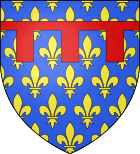 Coat of Arms of the House of Anjou-Naples
Coat of Arms of the House of Anjou-Naples
The royal House of Anjou is a cadet branch of the Capetian Royal House of France. It is one of three separate royal houses referred to as Angevin, meaning “from Anjou” in France. Founded by Charles I of Naples, a son of Louis VIII of France, the Capetian king first ruled the Kingdom of Sicily during the 13th century. Later the War of the Sicilian Vespers forced him out of the island of Sicily, leaving him with just the southern half of the Italian peninsula: the Kingdom of Naples. The house and its various branches would go on to influence much of the history of Southern and Central Europe during the Middle Ages.
History
Charles of Anjou was the posthumous son of king Louis VIII of France. His brother Louis IX who succeeded to the French throne in 1226 gave him the titles of Count of Anjou and Maine. The feudal County of Anjou was a western vassal state of France which the Capetians had wrested from the English only a few decades earlier. He married the heiress of the County of Provence, Beatrice of Provence who was a member of the House of Barcelona. After fighting in the Seventh Crusade, His Holiness Pope Clement IV, offered him the Kingdom of Sicily, which included not only the island of Sicily but also the southern half of the Italian peninsula. The reason behind this offer was a conflict between the Papacy and the Holy Roman Empire which was ruled by the House of Hohenstaufen.
It was at the Battle of Benevento that Charles gained the Kingdom of Sicily after he beat the Hohenstaufens and this was cemented after victory at Tagliacozzo. He signed the Treaty of Viterbo in 1267, an alliance with the exiled Baldwin II of Constantinople and William II of Achaea.
Taking advantage of the precarious situation of the remains of the Empire in the face of rising Greek power, he obtained confirmation of his possession of Corfu, the suzerain rights over Achaea, and sovereignty over most of the Aegean islands. Furthermore, the heirs of both the Latin princes were to marry children of Charles, and Charles was to have the reversion of the Empire and principality should the couples have no heirs. With few options to check the Byzantine tide, he was well placed to dictate terms.
The treaty also the possession of cities in the Balkans, the main one being Durazzo, Charles had fully solidified his rule over Durazzo by 1272, creating a small Kingdom of Albania for himself.
Charles’ wife Beatrice died on 23 September 1267, and he immediately sought a new marriage to Margaret, Countess of Tonnere, the daughter of Eudes of Burgundy.
Albania
Charles new kingdom extended from the region of Durrës (Durazzo, then known as Dyrrhachium) south along the coast to Butrint. A major attempt to advance further in direction of Constantinople, failed at the Siege of Berat ( 1280-1281). A Byzantine counteroffensive soon ensued, which drove the Charles out of the interior by 1281. The Sicilian vespers further weakened his position, and the Kingdom was soon reduced by the Epirotes to a small area around Durrës. The Angevins held out here, however, until 1368 when Stephen of Durazzo lost the city to Karl Thopia. In 1392 Karl Thopia’s son returned Durazzo and his domains to the Republic of Venice thus ending the rule of the House of Anjou in Albania.
Sicily 1266–1282
Charles administration of Sicily was generally fair and honest but it was also stringent despite this Charles unrest simmered in Sicily because its nobles had no share in the government of their own island and were not compensated by lucrative posts abroad, as were Charles’s French, Provençal and Neapolitan subjects; also Charles spent the heavy taxes he imposed on wars outside Sicily, making Sicily somewhat of a donor economy to Charles’ nascent empire.
The unrest was also fomented by Byzantine agents to thwart Charles’s projected invasion of Constantinople, and by King Peter III, who saw his wife Constance as rightful heir to the Sicilian throne. On the 3oth March, 1282 during the sunset prayer marking the beginning of the night vigil on Easter Monday at the Church of the Holy Spirit just outside Palermo, the uprising took place and was to be known as the Sicilian Vespers. Beginning on that night, thousands of Sicily’s French inhabitants were massacred within six weeks. Peter III of Aragon supported the rebels and joined the war that was to last until 4th September 1282, when Peter was crowned as King Peter I of Sicily though he ruled only over the island as Charles kept the southern part of the Italian peninsula that was to be known as the Kingdom of Naples.
Charles planned an invasion of Sicily but his health was failing him and the plan thwarted. He died in Foggia on the 7th January 1285.
Kingdom of Naples
After the death of Charles I, his son Charles II succeeded him on the Neapolitan throne and he in turn was succeeded by his son Robert on the 5th May 1309. Robert, the Wise, as he was known died on the 20th January 1343 and was succeeded by his grand daughter Joanna I, until her murder in May 1382. She was succeeded on the throne by her second cousin and son of Louis of Durazzo, Charles III who reigned until his death in 1836. The throne passed to his son, Ladislau, who reigned until his death on 6th August 1414.
Queen Joanna II was born on 25 June 1373, as the daughter of Charles III of Naples and Margaret of Durazzo. In 1414, she succeeded her brother Ladislaus and at that date she was 41 years old and was already the widow of William, Duke of Austria. She married twice, but had no children and had adopted Louis III of Anjou in 1431 but he died in 1434 and she offered his younger brother René to inherit her kingdom in his place. In 1438 he set sail for Naples, which had been held for him by his wife, the Duchess Isabel.
By then, the poverty of the Angevin resources enabled Alfonso V of Aragon, who had been first adopted and then repudiated by Joanna II, to make some headway in the kingdom of Naples, especially as he was already in possession of the island of Sicily to lay siege to Naples in 1441, which he sacked after a six-month siege. René returned to France in the same year, and though he retained the title of king of Naples his effective rule was never recovered. Later efforts to recover his rights in Italy failed. Thus effectively in 1441 the House of Anjou-Naples ceases to exist though Rene’s son, John II, Duke of Lorraine and Calabria considered himself titular King of Naples as did his son Nicholas of Anjou (1448–1473) who died without heirs.
The revival of the defunct Royal House of Anjou-Naples by King Alfonso XIII of Spain
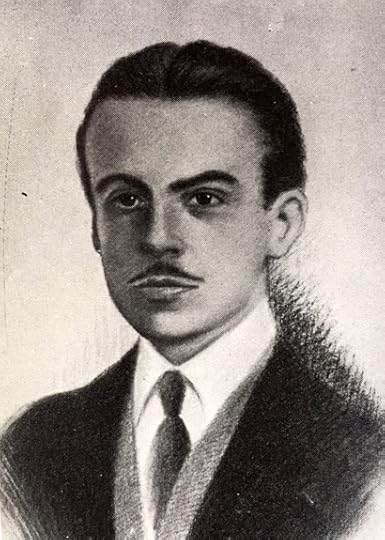 Basil d’Anjou-Durassow-Schiskow, who King Alfonso XIII of Spain proclaimed head of the defunct Neapolitan House of Anjou-Naples and recognized as Duke of Durazzo in 1911.
Basil d’Anjou-Durassow-Schiskow, who King Alfonso XIII of Spain proclaimed head of the defunct Neapolitan House of Anjou-Naples and recognized as Duke of Durazzo in 1911.
The story of the revival of the Royal House of Anjou-Naples is fascinating to say the least and it was the result of an act of revenge of the Spanish king against members of his family whose pretensions to the French throne, he considered were out of line.
To understand the full story we must go to the beginning of the family saga. The story starts with the starts with H.R.H Infante Don Enrique de Borbon, 1st Duke of Seville who was grandson and great.grandson of kings of Spain and brother in law to Queen Isabella II of Spain. His uncle, King Fernando VII of Spain had bestowed on him the title of Duke of Seville.
In 1833, his uncle the king died and the Court was divided between the supporters of the the new queen, Isabel II of their uncle, Infante Carlos Maria Isidro de Borbon , who founded what was to be known as the Carlist line. The maternal aunt of Don Enrique, queen Maria Cristina (she was sister of Don Enrique’s mother Infanta Luisa Carlota), widow of Fernando VII, was appointed regent for her young daughter.
The second marriage of the queen regent with Agustín Fernando Muñoz and Sánchez in 1833 caused disagreements between her and her sister, the infanta Luisa Carlota, a fact that ended up banishing Luisa Carlota and her family to Paris, where the aunt of both, Queen Maria Amalia, wife of Luis Felipe I of France.
Enrique and his brothers were educated in the French capital, and at the Lyceum Henri IV, he met his cousin, Antonio de Orleans. Already at that time there arose an intense rivalry between the two that would end, as will be seen, tragically years later. Don Enrique spent a season in Belgium, where his aunt, the wife of Leopoldo I of the Belgians, reigned. There they learned in 1840 that Queen Isabel II’s government had sent her mother the Queen Regent and her husband to exile.
Finally Don Enrique could return to Spain, and soon began his military career in Ferrol, where he was praised for his excellent conduct. In 1843 he was promoted to lieutenant of a frigate and was commander of the brig Manzanares. In 1845 he was already frigate captain, but that year would mark him for reasons beyond the naval militia.
At that time the possibility was discussed of marrying Don Enrique to the queen. Nevertheless, she ended up marrying his homosexual and effeminate brother, Infante Francisco de Asis, Duke of Cadiz. The queen’s younger sister, Luisa Fernanda married the Antonio of Orleans, Duke of Montpensier.
Offended by what he considered a grievance, and accused of having participated in a revolt against the monarchy in Galicia, the Infante was expelled from Spain in March 1846, shortly before the wedding of his brother and the queen, nuptials to which he did not attend. Don Enrique took refuge in Belgium, where his sister Isabel Fernandina was. At that time his name was shuffled as a possible candidate for the throne of Mexico, a matter in which don Enrique did not seem to be too interested.
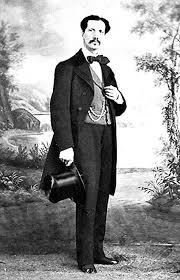 Don Enrique de Borbon, Infante of Spain and 1st Duke of Seville
Don Enrique de Borbon, Infante of Spain and 1st Duke of Seville
Shortly afterwards, in order to negotiate the Mexican affair, the infante was able to return to Spain, where he met Elena María de Castellví and Shelly (Valencia, October 16, 1821 – Madrid, December 29, 1863), daughter of Antonio de Padua de Castellví and Fernandez de Cordoba, XII Count of Villanueva, X Count of Castellá and VIII Count of Carlet, and Margarita Shelly of MacCarthy, sister of Edmundo Shelly and MacCarthy, Colonel of Infantry and Secretary of King Ferdinand VII . Soon an idyll arose between them, but the queen’s opposition was assured. The marriage, celebrated secretly in Rome, Pontifical States, 6 of May of 1847, did not enjoy in principle of the approval of Queen Isabel II. Once they returned to Spain the couple was expelled to Bayonne, and later settled in Toulouse.
From France Don Enrique proclaimed himself several times revolutionary, and even asked to join the First International. Immediately he was stripped of his titles, and ceased to be considered an infante of Spain. Meanwhile, his children were born without rank or title, and in 1849 he asked for the Queen’s pardon so that he could return to Spain. The family settled down in Valladolid in 1851, but soon they were forced to return to France. Later, in 1854 they were able to return to Spain, and they moved to Valencia, where their fourth child was born and where the second died, Luis. Don Enrique recovered his ducal title, but not that of Infante of Spain.
Shortly after the Duke of Seville returned to manifest his leftist ideas, and was again expelled to France. He was able to return in 1860, and ascended to the rank of general captain of the navy, and three years later was promoted to lieutenant-general. That year of 1863 his wife died giving birth to his fifth daughter, and was buried in the madrileño convent of Descalzas Reales, and not in San Lorenzo de El Escorial for not being an Infanta of Spain.
Between November of 1864 and January of 1865, he is exiled to Santa Cruz de Tenerife, Canary Islands, where contravening the orders of the authorities of Madrid was received with honors by the local authorities in their different visits to localities of the island As a member of the royal household. The 29 of January of 1865 he returns to the peninsula.
Don Enrique tried, in vain, to remarry a European princess, and soon began to attack the government of his sister-in-law and cousin, Queen Isabel II. His actions led to the deprivation of his titles and honors, and was again exiled in 1867.
Forgetting their close kinship with Isabel II, the Dukes of Montpensier, supported
with his great fortune the overthrow of the queen by the ultra liberal elements
of the army. after the success of the revolution of 1868, the Queen and Don Enrique found met in the Parisian exile, where the dispossessed Duke of Seville tried to persuade her cousin to abdicate in favour of her son, Prince Alfonso as a compromise solution to preserve the throne for the Bourbon dynasty. At that time the Queen refuse and after several letters of supplication to the revolutionary government, he was able to return to Spain. Back in Madrid, he soon tried to be considered for the vacant throne, for which his greatest rival was his childhood enemy, Don Antonio de Orleans, Duke of Montpensier, married to the exiled queen’s sister, Infanta Luisa Fernanda.
However, the revolutionaries had already pronounced against the Bourbons, who were accused of all the national ills and they had decided to invite to the Spanish throne a foreign dynasty. The Duke of Seville’s dream to lead a progressive monarchy had collapsed so Don Enrique’s main worry is the education of the future king, Prince Alfonso and his immediate situation and he tries in vain to persuade the Queen to educate the Prince of Asturias in England
in liberal and parliamentary principles, far away from the European conservative courts.
In 1869, he published a violently anti-montpensier pamphlet, in which he describes his opponents in his true colours. In a letter of March of 1870,
Don Enrique openly insulted the one who had been his enemy since childhood.
As was custom in those days, Montpensier reacted by challenging the Duke of Seville to a gun duel that took place on the 12th of March in the Dehesa de los Carabancheles. Don Enrique returned to Spain ready to confront that odious prince of Orléans, who had contributed so much to the overthrow of the Bourbon monarchy and of passage, to pay old personal accounts that dragged from as far as the times of the lycee in Paris! The Duke of Seville was killed that day.
Montpensier was sentenced to one month in exile and the payment to the family of Don Enrique of 30,000 pesetas, which the Duke’s sons refused to accept. He was buried in the cemetery of San Isidro de Madrid, since El Escorial, which would have corresponded for an Infante of Spain, was forbidden, after a massive masonic funeral. His children were left , in the exile of Paris, orphans and without resources, in the care of their uncle, the effeminate king consort, Don Francisco de Asis.
A distant uncle of the Bourbon-Seville, the last Duke of Parma, Robert of Bourbon, therefore, brother of Dona Margarita de Borbón-Parma (the queen of the Carlists), who took pity on the unfortunate fate of Don Enrique’s children, inviting them to live with him in Nice. Through the beneficent influence of this prince, that that he could get Don Carlos VII (king of Spain for the Carlists) interested in their fate and he invited them to join his army as cousins and princes of the House of Bourbon.
On the 16th of July of 1873, Don Carlos (VII) entered Spain followed by his army and accompanied by the young Don Enrique de Borbon y Castellvi and his brothers Don Alberto and Don Francisco de Paula.
The fact is that they fought in the fronts of Catalonia, Valencia and Aragon.
All three brothers served in the Carlist army against the foreign king Amadeo of Savoy that had been invited by General Prim to be king of the revolution and after his overthrow, the First Republic and they received decorations for their bravery. After the restoration of the monarchy with Alfonso de Borbon who was proclaimed Alfonso XII, they asked Carlos VII to release them from their oath of allegiance to his person as they did not want to fight against their cousin, the new king and they returned to France. From there, they enrolled to serve King Alfonso XII on the island of Cuba, in the war against the independence insurgents. Don Enrique, by then the II Duke of Seville, accepted the presidency of the Heraldic Council of France and walked his noble figure at the European Courts where he was always received as the prince of Bourbon he was. In 1870, he married Josefina de Paradé and Sibie, who gave him three daughters. After the premature death of King Alfonso XII, he was the victim of a cruel political persecution by the Queen Regent, Maria Cristina of Habsburg who did not forgive him for criticizing her. He died on the high seas, when he returned from
The Philippines, where he had held the position of Governor of Tabayas), in 1894.
In 1889, signed a document by which he reserved his rights to the succession of the crowns of Spain and Two-Sicilies, which constitute in itself a whole manifest against the injustice of their situation. It read:
“I, Enrique Pio de Borbón, Duke of Seville, head of the branch founded by the Infante de España don Enrique Maria Fernando de Borbón, Duke of Seville, my father, I solemnly declare before God and of men, to reserve in the most formal way and absolute all eventual rights to the crown of Spain and of the Two-Sicilies that I, my descendants, my brothers, their descendants and my sister, we have both from the point of view of the pragmatics of male succession as from the female. I declare to keep them forever, full and complete, for whatever may happen, in faith I sign it: Enrique Pío de Borbón, Duke of Seville.
Maisons-Laffite, France, on April 24, 1889.
This very significant document shows, again, despite all the disagreements with the Royal Family, the children of the Infante Don Enrique were aware of their rights and duties as Members of the House of Bourbon. So much so that, at the death of the II Duke, in 1894, his brother Francisco remained as head of his family and as such is proclaimed himself Duke of Anjou, that is: Head of t he entire Capetian House.
The gesture, so typical of an impulsive man provoked severe reproaches of very different sectors. Many historians consider it childish or anecdotal.
It is not in any way. Don Francisco de Borbon y Castelvi, knew well the laws of
primogeniture that govern the succession of the throne of France, and he was aware that his rights came solely from the indolent attitude of Carlos (VII) of Bourbon, the head of the Carlist who he had served, in regard to the Headship of the Capetian House.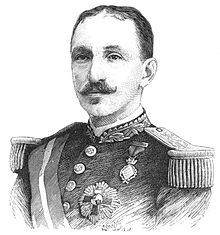 Don Francisco of Borbon and Castellvi
Don Francisco of Borbon and Castellvi
Nor is he unaware that after a hypothetical waiver of Don Carlos (VII) to his French rights, the Headship of the Capetian House would pass to King Alfonso’s branch but such proclamation would be unthinkable for supporters
of the monarchy in France who would have never accepted the possibility that one day the the crown of France would be worn by the Spanish king. Many French legitimists, fed up that Don Carlos’s attention was focused always in Spanish affairs and postponed his decisions regarding his rights to the French throne contacted the Don Francisco as the only table of salvation, before what they considered the spurious pretensions of the Orléans that proclaimed they were the true successors of the Count of Chambord (Henri V). Don Franciso hesitates between what he judges his duty to his family and the chivalrous loyalty to who was his first military Chief.
In the end, what he though was his duty to the dynasty prevailed as did the memory of his unfortunate father and he decides to stop the Count of Paris pretensions to the French throne suing him in the Civil courts for the misuse of
the full arms of France. The republican judges estimated the lawsuit as irrelevant S¡since the monarchy had been abolished and sentenced him to pay the costs. In Spain, as a result of these facts, he was condemned to two months of arrest in the castle of Santoña and his initiative greatly displeased Don Alfonso
XIII, which did not prevent Don Francisco, in a characteristic feature of his bountiful character, to return to manifest his pretensions to the French throne again in 1904 as well as the throne of the Two-Sicilies.
The matter collided to such an extent that, in 1911, King Alfonso XIII, unwilling to
admit the postulates of his cousin, recognized Don Basilio of Anjou-Durassow-Schiskow, an untitled Russian aristocrat , academic of the Russian Archeological Society, as Head of the Royal House of Anjou of Naples and Duke of Durazzo, making good a genealogy that made him descend directly from Robert de Valois, Prince of Morea and the Angevin kings of Naples. Tsar Nicholas II of Russia recognized Prince Basil as Head of the revived Royal House in 1916.
Prince Basil d’Anjou, born in 1887, married in Rome on the 15th of April 1947, Princess Olga Beatrice Dolgorouky. He was fourty years her senior. The Princess who was a beautiful, seductive and free spirited young woman, had eloped and married Victor Brimayer when still a minor and without the consent of her parents in 1945 and had a son, Alexis who was born on the 4th May 1946 in Costermansville (now present day Bukavu, Republic of Congo). Less than a year later and after Alexis’ birth, the illegal union was legally annulled. The marriage of convenience did not last very long but it served its purpose as Prince Basil who was allegedly an homosexual and had no heirs, acknowledged Alexis as his flesh and blood and Prince Alexis d’Anjou-Durassow was brought up as heir to the Neapolitan Royal House of Anjou-Naples
 H.R.H Princess Olga Beatrice Dolgorouky at the time of her marriage to Prince Basil in 1947.
H.R.H Princess Olga Beatrice Dolgorouky at the time of her marriage to Prince Basil in 1947.On the 4th of May 1966, his twentieth birthday, Prince Basil of d’Anjou-Durassow abdicated his rights as Head of the House of Anjou-Durazzo and Prince Alexis became Duke of Durazzo and Head of the Royal House. Prince Basil d’Anjou-Durassow, who had been in contact with Alexis throughout his life died in 1971.
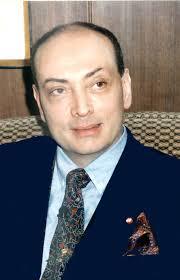 Prince Alexis d’Anjou-Durassow, Duke of Durazzo in Madrid 1985
Prince Alexis d’Anjou-Durassow, Duke of Durazzo in Madrid 1985Prince Alexis life was surrounded by controversy as can be read in my article The Truth about Prince Alexis d’Anjou-Durassow. He dies in 1995 in mysterious circumstances and many think he had been murdered as had his grandfather, Nicholas Dolgorouky, the ephemeral Volodar (King) of the Ukraine. He appointed Emilio Lobera, Baron de Lobera as regent of the Royal House of Anjou-Naples and he plans to offer the Headship of the Royal House to Prince Carlo of Bourbon-Two Sicilies, Duke of Castro and head of the House of Bourbon-Two Sicilies.
.
II Duke of Seville, Don Enrique de Borbon y Castelvi, who was the eldest son of H.R.H Infante Don Enrique de Borbon and his morganatic wife, Elena Maria de Castellvi, though he was a member of the Spanish royal family as grandson of King Carlos IV, he was not an Infante of Spain and thus had no right to be titled royal highness as the marriage of his parents had not received the permission of Queen Isabella II.
April 5, 2017
Wikipedia’s disgraceful censorship
I have intensively been working for the past few days on several articles for Wikipedia on Alexis d’Anjou-Durassow and the Royal House of Anjou-Durassow. The articles were thoroughly researched and had many references and footnotes and were a team work of a group of very serious and committed historians and journalists working together to try and prove what is known as the Survival Theory of the Russian Imperial Family. Our only interest is to uncover the truth, whatever this truth is.
Thus my articles were not biased and my only intention as an author and an amateur historian, in this particular case, was to shed light on this very fascinating and controversial character who has been slandered, after his death, without shame and mercy by people that have written articles in Wikipedia.
An encyclopedia such as Wikipedia that is based on additions of contributors is very interesting if it allows freedom of speech and other contributors are not allowed to practice censorship and vandalize articles. A few contributors with an obvious hidden agenda ganged against me by calling me a SERIAL HOAXER, deleted my articles and It is an absolute disgrace that a contributor is allowed to do so without contacting the other first and discussing whatever points might be contentious in order to clarify any possible misunderstanding or possible erroneous information.
To add insult to injury all editions that I have done to articles with no connection to the above mentioned articles have also been deleted without any consideration to the data or the facts and without giving me the opportunity to explain myself and my research.
This is cultural bullying and it goes against free speech. I am lost for words at such antics worthy of a regime such as North Korea!
January 30, 2017
Pope Francis’ war against the Vatican traditionalists and the Catholic branch of the Order of Malta
What started out as a fight over staffing of the Catholic branch of the Order of Malta, has escalated into a public battle between His Holiness Pope Francis and the ultra conservative Vatican forces who oppose his progressive policies.
The dispute began when British born Grand Master Mathew Festing sacked Grand Chancellor Albrecht von Boeselager who was accused of allowing the distribution of condoms to the poor in Burma. Von Boeselager protested that his dismissal was deeply unfair, a complaint that resulted in Pope Francis launching an investigation that was considered unacceptable to the Grand Chancellor who considered it meddling by the Pope in the Order’s internal affairs and refused any cooperation with the Pope’s commission of enquiry which in his opinion had no jurisdiction over the Order.
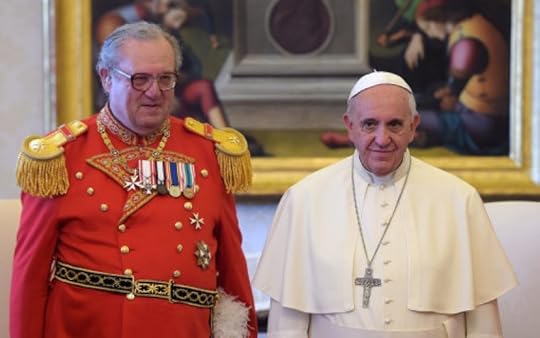 His Holiness Pope Francis and the former Grand Master of the Catholic branch of the Order of Malta, Mathew Festing
His Holiness Pope Francis and the former Grand Master of the Catholic branch of the Order of Malta, Mathew Festing
The Vatican reacted to the challenge with barely concealed anger, saying that the Pope had every right to intervene in the affairs of the order because as leader of the Catholic Church, he was its spiritual head. The row between the Vatican and the Grand Master has ended with his forced humiliating resignation and the appointment of a papal delegate that will govern the Order until a new Grand Master, supposedly with progressive views more in tune with those of His Holiness is appointed.
Immediately after the resignation of the Grand Master, the Pope announced that all “disciplinary procedures” against Mr von Boeselager were immediately scrapped and his suspension from the order, which had been decreed by Mr Festing, was annulled and he was reinstated as Grand Chancellor by the Sovereign Council, the governing body of the order.
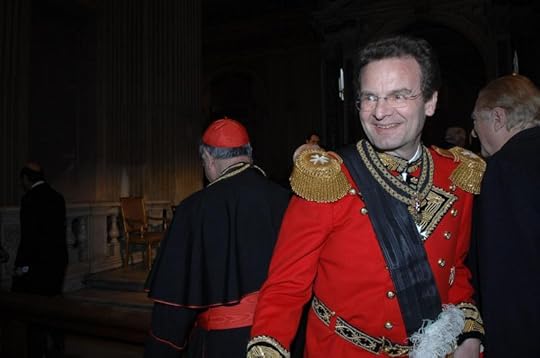 The Grand Chancellor, Albrecht von Boeselager
The Grand Chancellor, Albrecht von Boeselager
The New York Times has published that, “Conservatives have denounced what they call an illegal annexation of the Order and a purging by the a power- obssesed Pontiff, while liberal observers saw the whole episode as resulting from an act of subterfuge by the Pope’s most public critic within the Vatican hierarchy, the American cardinal Raymond Burke.”
The confrontation was viewed as a microcosm of the battle within the Vatican between conservatives and liberals, as Pope Francis upsets hardliners with his more compassionate stance on many important matters such as divorce, homosexuality etc.
The new political climate with the election of Trump as President of the United States and the rise of far-right populists in Europe have emboldened ultra conservatives in the Vatican who sense that the Pope could be vulnerable.
It is known that Pope Francis is critical of the paraphernalia surrounding the Knights of the Order and has, when he was cardinal in Argentina, a series of run-ins with the Argentinian Knights because of their display of wealth and their lack of charitable activities that in those days were limited to a charitable ball.
The resignation of the Grand Master has delighted the Pope’s followers around the world who support his compassionate approach as it has showed that conniving conservatives cannot push His Holiness around.
The Lieutenant Grand Master of The Sovereign Order of the Ecumenical Knights of Malta, Baron of Lobera has made a statement after the resignation of Mathew Festing: “We are glad that the unfortunate and regrettable dispute that the Catholic branch of the Order of Malta has had with His Holiness Pope Francis has been solved with the resignation of the Grand Master. Our branch has nothing to do with this dispute and we are totally supportive of His Holiness’ view point in this dispute.
We are purely a humanitarian organization with members of both genders, all religions and many different cultures serving the common good. We support fully the Declaration of the Vatican Council II, entitled Nostra Eatate, on the relations of the Church with non-Christian religions, one of the milestones in the propitiation of inter-religious dialogue, which spread through the Secretariat for non-Christians, instituted by H.H. Pope Paul VI in 1964, and continued with the Pontifical Council for the interreligious dialogue created by H.H. Pope Juan Pablo II in 1988 with the Apostolic Constitution Pastor Bonus. This policy is now followed by H.H Pope Francis”.
The Ecumenical branch of the Order of Malta moved to Russia and placed itself under the protection of the Tsars when the Order was exiled from Malta after Napoleon’s invasion of the island.
”
 The Lieutenant Grand Master of the Sovereign Order of the Ecumenical Knights of Malta O.S.J, Baron of Lobera
The Lieutenant Grand Master of the Sovereign Order of the Ecumenical Knights of Malta O.S.J, Baron of Lobera
October 8, 2016
Does Vladimir Putin know the true fate of the Russian Imperial Family?
A few days ago an article was published mentioning the profound interest that President Putin has shown in the re-investigation of the disappearance of Tsar Nicholas II ‘s and his family. His government created a new commission of experts and former President Dimitri Medvedev hand picked the historians and scientist that would work together with members of the Orthodox Church in the supposedly final investigation. They have worked for over a year with no results yet, at least not announced. But why would this new investigation be necessary? Why all the doubts after they announced in 1994 that the remains had been properly identified using DNA from royal relatives? Those remains were buried at the Cathedral of Peter and Paul and many members of the Romanov Family attended the ceremony. Then, what is wrong in this case?
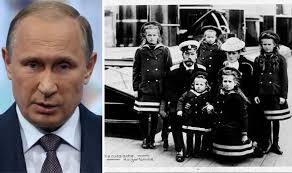
According to a Facebook page with thousands of followers from around the world, the true fate of the last Imperial Family of Russia was very different to what has been accepted for almost a century.
The page of The Russian Imperial Family Historical Society (RIFHS) http://www.facebook.com/RUSSIAN-IMPERIAL-FAMILY-HISTORICAL-SOCIETY-281626701958649/ is visited every day by hundreds of Romanov fans; some attracted by the romantic stories of the family, others with real historical interest because they believe that there are many facts that have not been revealed yet.
After the disappearance of the Romanovs in July of 1918, several articles in prominent newspapers outside of Russia reported them as “alive and in hiding”. Even the mother of the Tsar, Dowager Empress Maria Feodorovna, repeatedly affirmed till the last day of her life in 1928 the her son and his family were alive, living in hiding and surrounded by loyalists. She never went into mourning and remained in high spirits during the months following the alleged murder. The “official version” of the murders was published by investigator Sokolov in 1924, and from that moment on it was accepted as the truth, although serious historians, forensic experts and Romanov scholars have contested his findings and disputed his shallow arguments.
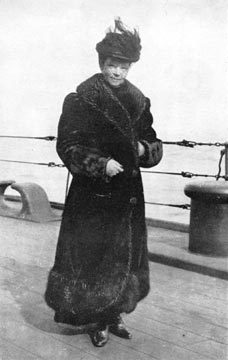 Dowager Empress Marie Feodorovna on board HMS Marlborough on her way to exile.
Dowager Empress Marie Feodorovna on board HMS Marlborough on her way to exile.In 1992, after the discovery of some putative bones of the Romanovs was announced, the Orthodox Church inside Russia raised their concerns, and so did a group of scholars and amateur historians from twelve different countries that have continued investigating this case in depth, visiting public and private archives, and gathering documents, letters, photos and testimonies in different languages and from truth worthy people.
In 1998, the Russian government announced the burial of the bones that had been identified as those of Nicholas II and four members of his family. Two skeletons were missing. When the state funeral of the so called “Romanov remains” took place, the Orthodox Church refused to participate. Alexei II, then Patriarch of Russia did not attend the ceremony and a few days before appeared on national television explaining the reasons why him and his group of investigators did not believe those bones belonged to the Imperial Family. During seventeen years they continued asking for a new investigation, especially after the surface of forty four bone fragments that were discovered and also identified as those of the missing skeletons.
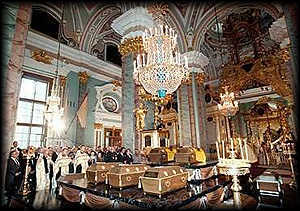 Burial at the Crypt of St Petersburg’s st Peter and Paul Cathedral on July 17th 1998
Burial at the Crypt of St Petersburg’s st Peter and Paul Cathedral on July 17th 1998Finally, in 2015 the Russian government ordered the re-opening of the investigation. The director of the State Archive A. Mironenko agrees that is necessary to take into account all the historical documents. This is the same claim that a group of dedicated historians in Ekaterinburg, led by Professor Veniamin Alekseev, have made since many years.
But their has also been keen interest in the west. In 2010 I became aware of the existence of several historians in Europe and in the USA that firmly believe that the truth about the fate of the Romanovs has not been told, yet. They are very excited about this new chance to scrutinize what has been told and written and reveal to the world the other story that has been banned to the public.
“This is a wonderful opportunity to discover the truth and set the record straight. Scientific proof is highly important. I believe DNA tests are crucial and must be taken into account; but also historical documents and lots of circumstantial evidence should be examined”. Said Marie Stravlo, an investigative journalist, author and translator that is now leading the RIFHS. I met her in Spain several years ago during one of her many research trips .
She started her own investigation in 1998 after receiving privileged information about the true fate of the Romanovs by a member of the Imperial Family of Germany, whose parents had strong blood ties with the Romanovs. Since January of 2009 Stravlo has been completely devoted to a full time investigation with amazing but controversial results. That same year she met other investigators that shared information and documents, and joined the Russian Imperial Family Historical Society. After traveling to nine countries on several occasions, and interviewing members of royal houses, other Romanov scholars, historians, authors and people with amazing knowledge of the story, she is absolutely convinced that there is ” another story, the real story”, that has never been told with regard to this case. During seven years she gathered not only stories about the members of Nicholas and Alexandra’s family that were never told before, but also photos, documents, testimonies and letters, hundreds of letters that could expose a different fate of the Imperial Family.
 Marie Stravlo
Marie StravloI have always had a core believe, from when I was a teenager, that Anastasia Manahan was Grand Duchess Anastasia and the story has always fascinated me. When I met Marie Stravlo and she kindly shared some of her findings, I was so impressed that I wanted to write a historical novel. She agreed to cooperate and allowed me to use the story about a lost Romanov Icon that belonged to Grand Duchess Maria Pavlovna, daughter of Tsar Paul I. The book, published in 2012 under the titled THE LOST ROMANOV ICON AND THE ENIGMA OF ANASTASIA,
http://www.thelostromanovicon.com/ refers to the religious relic, but also to the case of Anna Anderson, providing information and documents which prove that she was Grand Duchess Anastasia. It is also an eye opener to all this case.
Marie Stravlo has published three books related to the topic. Another is ready to be published in 2017 and is working around the clock on a new biography of the Romanov women that will surprise the world.
I am very pleased because she agreed to work with me on the sequel to The Lost Romanov Icon.
It is very possible that President Vladimir Putin knows the truth. As a former KGB agent he might have had access to classified information from the Cheka, the acting secret police when the Romanovs disappeared. Cheka files are still classified, despite the many years that have passed and the requests by historians to read their content. President Putin is waiting for the final conclusion of the team of investigators appointed by the government, to prove one version or the other, and close the case forever.
“I believe that the people of Russia deserve to know the truth. It’s Russia’s past. It’s Russia’s history. But also the rest of the world needs and wants to know what happened in Ekaterinburg, at the Ipatiev House, during the night of July 16-17, 1918, once and for all”. Said Marie Stravlo when I met her, and I fully agree with her.
If the Romanovs were rescued and survived, what happened to them? I have had lengthy talks with Marie Stravlo and I think she will soon have most of the answers which I trust she will reveal in her future publications; or perhaps we all will have to wait until the Russian government and the Orthodox Church announce their findings and close this fascinating case forever.
I personally have concluded that the Imperial Family did survive and I trust that this fact will be finally revealed and history re.written.
For further info on Marie Stravlo https://www.facebook.com/Marie-Stravlo-AuthorEscritora-369513416415351/?fref=ts
Interesting Facebook page on Grand Duchess Anastasia Nicolaievna https://www.facebook.com/search/top/?q=anastasia%20romanov%20manahan%20historical%20society
October 1, 2016
La Infanta Cristina victima de la conspiracion criminal de Manos Limpias/Ausbanc
Ayer vi por casualidad un programa de investigación en LA SEXTA TV sobre Manos Limpias/Ausbanc y me quede realmente alucinado de lo que vi y escuche.
Manos Limpias había nacido como una organización de representación de empleados de la función publica para luchar contra la corrupción y se había aliado con una asociación de usuarios de servicios bancarios llamada Ausbanc.
La relevancia de Manos Limpias no se debe tanto a sus acciones sindicales como a las abundantes denuncias presentadas como acusación popular sobre temas variados que afectan a la política municipal y nacional y siempre buscando los mas mediáticos como fueron el caso Pujol, de las Ere, la pitada al himno nacional en el Camp Nou y últimamente, el caso Noos.
Por su parte, Ausbanc nació con el objetivo defender los derechos e intereses legales de los usuarios de los servicios bancarios prestados por las entidades de crédito y los establecimientos financieros de crédito y a todos los consumidores y usuarios en cualquier ámbito.
Las dos entidades han resultado ser dos caras de una misma maquinaria de extorsión, engrasada durante décadas. Ambas organizaciones, que se presentaban como luchadores altruistas contra la corrupción y en favor de los consumidores, se han revelado como unas estructuras levantadas para el enriquecimiento ilícito de sus dirigentes,
Una de las victimas de estos dos siniestros personajes ha sido S.A.R LA Infanta Doña Cristina. Manos Limpias como acusación popular no paro hasta conseguir verla sentada en el banquillo a pesar de todos los informes en contra de la fiscalía del estado. Todo ello con el objetivo de extorsionar al circulo de la Infanta, la cantidad de tres millones de euros.
Es en mi opinión grave e injusto hacer pasar a una Infanta de España por el amargo trago de tener que declarar como imputada, pero es gravísimo y roza los limites de otro delito, el imputar a Doña Cristina sabiendo que la imputación afectaría de manera muy negativa a la imagen de la institución monárquica. Todo ha sido premeditado para causar el mayor daño al Rey Felipe VI pues es de sobra conocido que ambos sinvergüenzas tienen simpatías ultra derechistas y que el presidente de Ausbanc había sido militante de Fuerza Nueva, partido que fue enemigo acérrimo de la monarquía parlamentaria a la que consideraban traidora a los principios del Movimiento Nacional.
A mi siempre me sorprendió la inquina y el odio que la abogada que representaba a Manos Limpias, Virginia Lopez Negrete mostraba hacia la figura de la hermana del Rey. En mi opinión la acusación de Manos Limpias no solamente era totalmente temeraria pero era una acusación con mala fe. Intente convencerme de que al menos sus intenciones serían honorables. Finalmente, todos hemos podido ver que las intenciones de Manos “Sucias” estaban en las antípodas de la honorabilidad.
El presidente de Ausbanc, Luis Pineda, prometió en una conversación telefónica “plegar velas” en la acusación contra la Infanta Cristina en el caso Nóos e incrementó de dos a tres millones de euros el pago requerido para hacerlo, argumentando que la causa generaba “muchos gastos procesales”.
En el auto en el que envía a prisión a Pineda y al secretario general de Manos Limpias, Miguel Bernad, el juez Santiago Pedraz detalla la estrategia de ambos para intentar negociar la retirada de la acusación “a cambio de un acuerdo que les beneficiaría económicamente”.
El primer contacto impulsado por Pineda se produjo el 29 de febrero a través de una llamada al director general de la Fundación La Caixa en el que le propone un pacto. La intención era pactar una declaración convenida que pudieran después utilizar para justificar su decisión de apartarse del juicio.
Pocos días después, el responsable de la asociación de usuarios de cajas transmitía al también arrestado Francisco Javier Castro Villacañas sus impresiones sobre el papel de la abogada de Manos Limpias Virginia López Negrete.
En su opinión, la abogada Virginia López Negrete se había “pasado” en su intervención en ocasión de la declaración de la hermana del rey Felipe VI, que tuvo lugar el 3 de marzo. “Tendrá que plegar velas y punto”, dijo y agregó que la letrada ya había tenido su “momento de gloria” y tendría que asumir la decisión le gustara o no.
La estrategia estaba dirigida por Pineda que mantuvo numerosas conversaciones con el secretario general de Manos Limpias, Miguel Bernad. “Era Pineda el que marcaba las pautas”, precisa el auto.
Unos días después de la declaración de la Infanta en el juicio, el 14 de marzo, Pineda llamó a otro banco, en este caso el Sabadell. En concreto, se puso en contacto con el subdirector general de la Asesoría Jurídica y le pidió que hablara con el abogado defensor de la hija del Rey don Juan Carlos, Miquel Roca.
El auto desvela que seis meses antes, en septiembre, Bernad ya había realizado un primer tanteo. Entonces el secretario general de Manos Limpias, propuso a este directivo del Sabadell que “ayudara” al responsable de una empresa de seguridad que se encontraba en una grave situación económica. La cantidad solicitada era entonces de dos millones de euros.
El subdirector del banco catalán denunció los hechos a la Policía, a la que dijo que nunca tuvo intención de ceder a las propuestas de Pineda y quería “informarse” y ganar tiempo para conocer sus intenciones reales.
Miguel Roca, abogado de la Infanta, también acudió a las autoridades a las que dijo que no quiso reunirse con ninguno de ellos por motivos deontológicos pero que tenía “cierta curiosidad por saber lo que podían proponer”.
Afortunadamente la Policía de Delitos Económicos llevaba tiempo investigando a los dos criminales que han sido detenidos y enviados a prisiòn sin fianza desde el pasado 18 de Abril por extorsión, amenazas y organización criminal.
Segun el diario El Pais, La “organización criminal” destapada en torno a Manos Limpias y Ausbanc, que acudían de la mano a procesos judiciales y chantajeaban a los querellados para retirar las querellas presentadas previamente contra ellos, tenía en su cúspide a Pineda. Este antiguo dirigente ultraderechista, encarcelado en 1981 tras promover altercados a favor del golpe de Estado del 23-F, fundó Ausbanc en 1986. Tras formarse un nombre en la defensa de los clientes de la banca, la asociación comenzó a desarrollar la actividad que ha permitido a Pineda hacerse millonario: extorsionar a las entidades bancarias a quienes garantizaba buena imagen pública en sus ránkings a cambio de dinero.
La fórmula más habitual de cobro era la inserción de anuncios publicitarios en las diferentes revistas del grupo Ausbanc, cuyas tiradas eran tan exiguas como potente era su repercusión en el sector financiero. Durante más de dos décadas gran parte de los bancos y cajas españoles pasaron por el chantaje de Pineda. En los últimos cinco años, la asociación amasó 7,1 millones de euros por este método. Las entidades que optaron por negarse se convirtieron inmediatamente en el blanco de sus ataques. En 2014, cuando sus métodos de chantaje eran de sobra conocidos en el sector bancario, Ausbanc fue expulsada del Registro Estatal de Asociaciones de Consumidores, lo que le inhabilitaba para recibir subvenciones públicas (en 2004 percibió 309.000 euros, y el resto de años se están analizando).
En fin, no hay duda de que Iñaki Undangarin como mínimo ha sido una marioneta de su socio Diego Torres, que tal vez sea culpable de todo lo que se le acusa y cuando se dicte sentencia tendrá que asumir la responsabilidad de la que se le inculpe. Yo por mi parte no le puedo perdonar el daño que ha hecho a la Corona y a España sin ninguna necesidad o justificación. Todo por una absurda ambición innecesaria pues sin duda hubiera podido llegar hasta ser Presidente del Comite Olimpico Internacional. Antes del escándalo del caso Noos, los ex Duques de Palma de Mallorca eran admirados y queridos hasta en Cataluña!
Me entristece el calvario que ha sufrido la Infanta Doña Cristina. Me produce congoja pensar en el devastador efecto que esta terrible odisea haya podido tener sobre sus hijos, también victimas inocentes como ella. La indignidad de ser imputada en un caso en el que hasta la fiscalía del estado decía no tenia ninguna responsabilidad, es ya un precio altísimo que ha tenido que pagar por la amoralidad de dos personajes siniestros cuyo único afán era el lucro despiadado y la venganza cuando vendían altruismo. La Infanta Cristina ha sido victima de una conspiración criminal con la intención de extorsionar 3 millones de euros y al mismo tiempo dañar al máximo la buena imagen de la figura de Su Majestad el rey Felipe VI y la institución monárquica. Hay algo mas deleznable y repugnante?
July 29, 2016
The human cost of terrorism
So far this summer, the pace and scope of the killings are dizzying. Bombs have exploded in Bhagdad, Nice, Istanbul, Orlando, Dhaka, Djakana, Lafoole, Tal Abyad, Kot, Mogadishu, Qaa, Al Mukalla, Medina, Lahore, Al Hasakah, Um al Housh, Aleppo, Mosul, Aden, Kabul, Qamishli, Ankara, Iskandariya, Brussels etc. Each explosion or bullet has teared holes in homes and communities causing unbearable pain to the families and friends of the survivors.
In just a couple of months hundreds of lives cut short by heinous acts of terrorism and its important to reveal the humanity lost and that a life is a life, wherever and whenever it is curt short. All these acts of terror have a ripple effect to the immediate surviving relatives: people who have lost parents, spouses, siblings or friends.
Most of the victims, young and old, have left behind parents, whose language of mourning trascends borders and cultures. It is a pain that surely is indescribable. Victims ages range from mid eighties to even unborn babies with must in the prime of their lives.
Among the victims, there were Jews, Christians, Atheists and even Hindus but a large number of them were Muslims. The cowardly attack at the Lahore Park that targeted Christians families killed more Muslims!
American, French, Chinese, Congolese, Lebanese, Syrian, Saudi Arabian, Turkish, Afghans, Egyptians, Israelis, Macedonians, British, Peruvians, Germans, Nigerian, Somalian and other nationalities were among the victims who were also musicians, teachers, students, waitresses, police officers, farmers. home makers, business men and from many other professions.
The result of this madness is hundreds of families torn apart with surviving relatives and friends trying to hold close to the last moments with loved ones, parsing them for deeper meanings.
What emerges is a tapestry of hundreds of anonymous lives interrupted and of which we barely know much about, if it was not for anecdotal shards or bits of memory shared in the press by those left behind, in the details of their dreams and the things left undone.
If ony the perpetrators just stopped to reflect on this and how they would feel if their loved ones were to suffer a similar fate, they might re-consider being the cause of so much suffering. They too have parents, spouses and siblings and should feel some empathy.
Pope Francis has just said: ” The world is at war. Not a war of religion. There is a war of interests. There is a war for money. There is a war for natural resources. There is a war for domination of peoples. This is the war. All religions want peace. Others want war. Do you understand?”
The Dalai Lama often repeats that, “Violence only generates more violence!” and this is definitely true but what is the solution to these terrible attacks that are fast becoming part of our daily lives? I wish I would have the answer but I do not. The only thing I am certain of is that we can’t play into the hand of the terrorists by changing the way we live, by feeling apprehension to those different to us, by posting hate messages on our social media or by alienating ourselves from our fellow human beings with whom we at last have one thing in common and that is our yearning to find happiness.
July 16, 2016
In defense of Secularism in Turkey
Mustafa Kemal, known as Atatürk led Turkey into the modern world after the fall of the Ottoman Empire. Under his leadership, thousands of new schools were built, primary education was made free and compulsory, and women were given equal civil and political rights, while the burden of taxation on peasants was reduced. He was and still is considered by most Turks as the Father of a Secular modern nation and the principles of his reforms are enshrined in the Constitution.
The Turkish President since 2014, Recep Tayyip Erdoğan served previously as Prime Minister from 2003 to 2014. When he was first elected PM the hoped that he would serve as a democratic model for the rest of the Islamic world. That was a long time ago.
But Erdoğan is fast becoming a dictator. Not long after his initial election, his agents embarked on a large and sinister campaign to destroy his political opponents, jailing hundreds—journalists, university rectors, military officers, aid workers—on trumped-up charges and fabricated evidence. Unfortunately, despite his excesses, he has remained fairly popular as the Turkish economy rapidly grew. In 2014, having completed three terms as Prime Minister, he ran for President and won. The legacy of Atatürk is probably the reason why Turkish voters have refused to give him the blank check he desired, and last year turned down his effort to modify the Constitution to give himself vast new powers.
Since becoming President, Erdoğan has made a further turn toward dictatorship, crushing the remnants of a free press. Dexter Filkins in his article for New Yorker: Erdogan’s March to Dictatorship wrote, ” In December, 2014, Turkish police arrested the editor of Zaman, the country’s largest newspaper, which had not only been a critic of Erdoğan but also written extensively about the corruption that pervades his government and family. The editor, Ekrem Dumanlı, was accused of trying to mount a coup d’état. Earlier this month, the government seized Zaman and began printing pro-government articles.
The problem for Erdoğan was that the Cumhuriyet story came out just as he was succumbing to pressure from the Obama Administration to switch his policy and join the fight against ISIS. You can imagine what a hypocrite Erdoğan felt like when the Cumhuriyet story hit the stands. In November, government agents arrested its two top editors, Can Dündar and Erdem Gül, both veteran journalists, on charges of espionage. Prosecutors are demanding life sentences for the pair. Erdoğan himself is a plaintiff in the case. Last week, a judge ordered the trial closed to the public.
Erdoğan’s campaign against Cumhuriyet has coincided with an equally brazen assault on Kurdish journalists, at least a dozen of whom have been arrested and detained on charges that they support terrorism. There are at least twenty reporters now imprisoned in Turkey, according to Nina Ognianova, of the Committee to Protect Journalists, in New York. “It’s so hard to get information that we aren’t sure how many journalists have been detained,” Ognianova said. “The campaign is unrelenting.”
According to the same article in the New Yorker, President Obama has changed his view on Erdogan: “In discussions with Jeffrey Goldberg, of the Atlantic, Obama said that while he once imagined Erdoğan as a moderate, he now sees him as an authoritarian and a failure.”
Yesterdays failed coup against Erdogan has been costly in lives. Reuters say that over 200 dead and close to 1000 injured and this is inadmissible. By asking his supporters to go out to the streets against the coup, the government is also responsible for this toll result of the violence.
Since Atartürk founded the modern secular republic of Turkey in 1923, the Turkish military has perceived itself as guardian of Kemalism, the official state ideology, even though Atatürk himself insisted separating the military from politics. Since then the military has both been an important force in Turkey’s continuous Westernization and enjoys a high degree of popular legitimacy, with continuous opinion polls suggesting that the military is the state institution that the Turkish people trust the most.
Military rule is no solution to a country’s problems and in Turkey until the restoration of democracy there was much repression and many people were incarcerated and killed under military rule. Yesterday’s coup was made in the name of Kemalism and according to the military leaders behind it, in the name of democracy and secularism. Democracy is paramount and must preserved in Turkey at all costs.
The Turks should be able to get rid of Erdogan, if that is their wish, through the ballot box but that will be difficult as he has control of the press and his repressive tactics will help him remain in power indefinitely unless he has learned the lesson from this coup attempt.
The coup has failed and the government has announced that close to 3000 members of the military have been detained. Erdogan has announced that there will be no mercy and the government is considering re-instating the death penalty. That I believe is a big error. Negotiation, mercy and compassion should be his tools to appease the Army. He should realize that as a democratically elected President he has to abide by the constitution of his country. Kemalism must be kept alive and it is now up to the Western leaders to leave diplomatic language aside and goes straight to the point: that any leader who jails journalists, bombs the Kurds and jails his opponents—is no friend of the the West. This is how we can help maintain democracy in Turkey.
April 2, 2016
Why the United Kingdom should leave the EU?
On the 23rd of June, we, British, Irish and Commonwealth citizens over 18 who are resident in the UK have the right to vote in a referendum to decide if we want to stay in the EU or leave. The Conservatives, the Labour Party and the Liberals are promoting to stay in the EU though about half of Conservative MPs, including five cabinet ministers, several Labour MPs and the DUP are in favour of leaving. The party united in its stance to leave the EU is the UKIP.
I had the privilege of spending a weekend at the home of the Member of the European Parliament for the South West Counties & Gibraltar for UKIP, William Legge, Earl of Dartmouth and discuss the pros and cons of the UK leaving the EU. Before this weekend, I had read extensively the government’s arguments of why we should stay in the EU and after much consideration I have arrived to the conclusion that the best for the UK is definitely to divorce amicably the EU and regain control of our affairs.
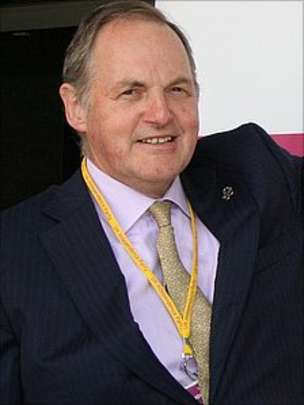 WIlliam Legge, 10th Earl of Dartmouth, MEP
WIlliam Legge, 10th Earl of Dartmouth, MEP
The government and it’s allies are arguing that we should stay for the following reasons:
1) 3 million UK jobs are dependent on trade with the EU
2) The UK exports to the EU will cease after Brexit.
3) The EU negotiates trade agreements with the rest of the world. Outside the EU Britain would have to renegotiate trade deals alone. While the EU is the world’s largest market, a UK outside the EU would not be a high priority for other counties to negotiate a trade deal.
4) As 28 democracies, and as the world’s biggest market, we are strong when we work together.Britain is represented in many international organizations in joint EU delegations – giving Britain more influence than it would have alone. The EU has played a major role in climate, world trade and development.
5) Common rules for the common market make it unnecessary to have 28 sets of national regulations.
6) The European Arrest Warrant replaced long extradition procedures and enables the UK to extradite criminals wanted in other EU countries, and bring to justice criminals wanted in the UK who are hiding in other EU countries. Europe just helps UK authorities work with other EU countries’ to tackle international organised crime such as drug smuggling, people trafficking and money laundering.
7) 1.4 million British people live abroad in the EU. More than 14,500 UK students took part in the European Union’s Erasmus student exchange scheme in 2012-13. Driving licences issued in the UK are valid throughout the EU.
8) As 28 democracies, and as the world’s biggest market, we are strong when we work together. Britain is represented in many international organisations in joint EU delegations – giving Britain more influence than it would have alone. The EU has played a major role in climate, world trade and development.
9) Investment in the UK would diminish if we exit the EU
But the truth is the following:
Our membership of the World Trade Organization protects us from vexatious actions by trading partners so the jobs would not be at risk.
The other EU Member States export more to the UK than we do to them and in any case we could have an agreement as Norway has by which has access to the single market but is not bound by EU laws on areas such as agriculture, justice and home affairs. Though the government states that the divorce would not be amicable it would as the UK is the 6th largest economy in the world, 2nd largest economy in Europe, second largest exporter of services in the world and the world’s number one financial center. Taking this into account it would be in the interest of the EU that the divorce is more than amicable!
Since 1975, all of the UK’s Trade Agreements have been negotiated by the EU Trade Commissioner that has to take into account the interests of ALL Member states, many of which are protectionists. Exit would relieve 100% of our economy from the burden of EU regulations. A fact is that the majority of small and medium sized firms do not trade with the EU but are restricted by a huge regulatory burden imposed from abroad. 100% of the UK’s economy is subject to the burden of EU regulation. Less than 10% of the UK GOP derives from exports to the EU. Indeed up to 95% of the UK firms do not sell to the EU at all!
The UK outside of the EU would be able to negotiate a new trade agreement with the EU and we would regain our ability to negotiate trade agreements in our national interest by reactivating our seat in the World Trade Organization. By being in the EU we have no control over trade policy so we are banned from negotiating deals with our natural partners, the Commonwealth nations. The crude reality is that while the countries in the Commonwealth are growing at a predicted rate of 7.3%, the EU’s share of global wealth is projected to be only 15% in 2025. We must not forget that there are 53 countries in the Commonwealth with over 2.2 billion population
In a world united against a common enemy: Terrorism, as it is now, Europe would continue helping UK authorities to tackle international organized crime and share security information and vice versa. The EU cooperates with Switzerland and Norway, European nations not on the EU or other non- European allies.
Over 3 million European nationals live in the UK whilst under 1.5 million UK nationals live in the EU. Undoubtedly agreements would be reached when the exit agreements comes into effect, to protect the interests of these citizens. The reality is that currently over 450 million people in the EU have the absolute right to live, work and settle in the UK. Open Trade should not mean Open Borders!
The UK has little influence in the EU. Just 8.24% of the votes in the Council of Ministers and even this influence is declining. Outside of the EU we would recover our full sovereignty including parts of our Common Law, control over the NHS, Royal Mail and our fisheries etc.
Free from EU rules and regulations, Britain could reinvent itself as a Singapore-style supercharged economy and investment will pour in and would continue to be the Financial Center of the world.
As the Mayor of London, Boris Johnson has said: “This is a moment for Britain to be brave, to reach out – not to hug the skirts of nurse in Brussels and refer all decisions to someone else.”
My conclusion is that the UK does not need to be in a Political Union in order to trade. Britannia can be great again but definitely outside the EU. Latest polls seem to suggest that their is a growing number that have reached the same conclusion. We will see on June 23rd.
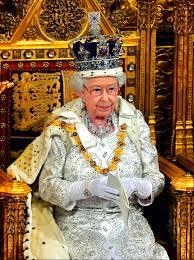 Queen Elizabeth of the United Kingdom of Great Britain & Northern Ireland, of Canada, of Australia, of New Zealand, of Jamaica, of Belize, of Papua New Guinea, of Antigua & Barbuda, of Grenada, of Barbados, of the Bahamas, of St Kitts & Nevis, of Santa Lucia, of Saint Vincent & the Granadines, of the Solomon Islands and of Tavulu.
Queen Elizabeth of the United Kingdom of Great Britain & Northern Ireland, of Canada, of Australia, of New Zealand, of Jamaica, of Belize, of Papua New Guinea, of Antigua & Barbuda, of Grenada, of Barbados, of the Bahamas, of St Kitts & Nevis, of Santa Lucia, of Saint Vincent & the Granadines, of the Solomon Islands and of Tavulu.
Sources: The Economist, The Daily Telegraph, Financial Times, Daily Mail, The Guardian, Lord Dartmouth, Express
http://www.telegraph.co.uk/news/2016/04/01/french-more-keen-on-brexit-than-british-says-major-poll/
March 26, 2016
Face to Face talks between His Holiness The Dalai Lama & President Xi Jinping
The current Chinese President, Xi Jinping and the 5th generation of China’s leaders have inherited China’s illegitimate rule over Tibet. 60 years of failed policies and increasing repression have contributed to a situation where, up to now, more than 150 Tibetans have felt compelled to set light to themselves as an act of protest.
There is no doubt that China’s Tibet policies are a failure. Four generations of China’s leaders have attempted to quell unrest in Tibet through successive crackdowns and unsustainable economic subsidies, which – far from bringing about the stability they seek – have served to exacerbate Tibetan grievances and created widespread resistance right across Tibet.
Xi Jinping and the 5th generation of Chinese communist leaders must immediately revise China’s Tibet policy, lift the military crackdown and address the Tibetan people’s legitimate grievances and aspirations for greater freedom.
From 2005 to the present time, there have been numerous international resolutions and recognitions on Tibet from bodies such as the United Nations High Commission on Human Rights, the United State Congress, the European Parliament, the Parliaments of Australia, Italy, Germany, Luxembourg, France and the World Parliamentarians Convention.
Since the first round of talks between representatives of the Tibetan Government sent by His Holiness the Dalai Lama to China to find a peaceful solution to the Tibetan tragedy based on His Holiness’ “Middle Way Approach”, and until the resignation of His Holiness’ envoys in 2012 due to their frustration over the lack of engagement on the Chinese part to find a solution, it has become clear to the world that China’s procrastination has only one objective: To hold eternal talks with the only objective of ending up assimilating Tibet.
During my visit to Dharamsala a few days before the Tibetan elections, I had the opportunity to speak to many Tibetans of different walks of life and they all agree that the situation is now critical and a solution needs to be found. In my view, the only chance for a solution is face to face talks with no preconditions between the Dalia Lama and Xi Jinping. Who better to host them and act as an arbitrator that President Barack Obama who during his meeting with His Holiness in Washington DC in February 2014, reiterated his support for the Middle Way Approach to resolve the long standing differences between the Communist regime and the Tibetans.
Though no official results have been yet announced, it seems that the newly elected Tibetan government will be headed by Prime Minister Dr.Lobsang Sangay, and as soon as the official announcement is made, he should loose no time and request that the American President organizes these direct talks as soon as possible. President Obama is only in office until November so there is not much time left.
Maybe I am naive but I have no doubt that when Xi Jinping meets the Dalai Lama and has the opportunity to talk candidly with him, he will realize that the Dalai Lama is China’s solution for Tibet and not the problem but in order for these talks to be successful they must be at the highest level. Meetings between representatives of the Tibetan government and low level Chinese officials are a total waist of time as we have seen from these meetings during more than a decade.
This scenario would be a win win situation for the Tibetan government because the following possible outcomes could occur:
*That President Xi Jinping accepts to attend, in which case as I have mentioned before, I have no doubt a solution could be found
*That Xi Jinping refuses to meet with His Holiness , in which case the whole world would see what exactly the Communist party’s true intentions are in Tibet: the assimilation of Tibet into China and the destruction of the Tibetan identity and its unique culture.
*The press coverage of just the official request by the Tibetan government to President Obama to hold these talks (independently if they take place or not!) would put the Tibetan cause back on the front pages of the world press. If the talks are finally held the press coverage would be enormous, something that has not happened with news of the individual tragic self-immolation of desperate Tibetans and a reminder of the deep frustration in the exiled community over the lack of progress in winning any measure of freedom in Tibet. To be in the front pages of the world news is now vital for the very survival of Tibet and its culture.
For President Barack Obama it would also be a win win situation. If he manages to host the talks his legacy would be written in the books of history. Tibet has many friends in the government of the United States and this request by the Tibetan Government should be most welcome.
Dhardon Sharling, 34, a member of the Tibetan parliament, said to the New York Times a few days before the elections: “All we should be talking about is how we will resolve Tibetan’s issues, how we’ll take the Sino-Tibetan dialogue forward.”
I have had the honour of meeting His Holiness of numerous occasions and I have devoted part of my life to the Tibetan cause and that is why I believe I can make this proposal that I am certain will benefit the plight of Tibet. In my view, the newly elected parliament and the members of the opposition now need to make these talks happen.
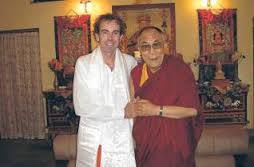 with His Holiness in Dharamsala on his 70th birthday,
with His Holiness in Dharamsala on his 70th birthday,
Xi Jinping can either resolve the Tibet issue swiftly and peacefully, or face a growing Tibetan resistance that threatens to undermine the very stability and endurance of the 5th generation of the Chinese Communist Party. Xi Jinping’s challenge is a people and a nation as united and undiminished in their spirit and resistance to China’s rule since the day the People’s Liberation Army invaded Tibet over 60 years ago.

